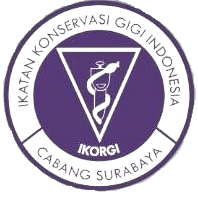THE EFFECT OF COMBINATION CALCIUM HYDROXIDE-PROPOLIS APPLICATION TO AMOUNT OF NEUTROFIL CELLS ON WISTAR RAT PULP PERFORATION
Downloads
Background: Pulp inflammation can be treated with pulp capping by calcium hydroxide as the gold standard. Pulp capping by calcium hydroxide could causing tissue necrosis followed by inflammation. Calcium hydroxide combined with propolis which have anti-inflammatory effects through inhibition of the Nf-kB pathway and pro-inflammatory cytokines. That process will inhibit the increase of vascular permeability and neutrophil chemotaxis. Inflammatory process can accelerate by controlling the amount of neutrophil cells as a acute phase marker, so the healing process occurs more quickly. Therefore it is necessary to study the amount of neutrophil cells in the pulp perforation of Wistar rats after applicated by combination of calcium hydroxide-propolis. Purpose: To analyze the difference amount of neutrophil cells on the Wistar rats pulp perforation after applicated by calcium hydroxide-propolis combination compared with calcium hydroxide-aquadest Method: M1 tooth perforated for all groups with three types tratment: no medication (control group), calcium hydroxide-aquadest 1: 1 (P-1 group), and calcium hydroxide-propolis 1: 1.5 (P-2 group) and closed with cention. Observations were made on the 1st, and 3rd day with HE staining. Results: One Way ANOVA shown a significant difference (p <0.05) of the average amount of neutrophil cells between all treatment groups on 1st day (p=0,000) and 3rd day (p=0,000). The amount of neutrophil cells in the calcium hydroxide-propolis (P-2) combination group was lower than control group and calcium hydroxide-aquadest (P-1) group on the 1st and 3rd day. Conclusion: The amount of neutrophil cells after application of calcium hydroxide-propolis is lower than calcium hydroxide-aquadest application.
Fatimatuzzahro N. Perubahan Histologis Jaringan Pulpa sebagai Respon terhadap Aplikasi Bahan Etsa. Stomatognatic (J K G Unej). 2015;12(1):5–10.
Maya Dyaningsih D, Praharani Bagian Periodonsia Fakultas Kedokteran Gigi Universitas Jember D. Pengaruh Pemaparan Entamoeba gingivalis Terhadap Jumlah Polimorfonuklear Neutrofil (PMN)Pada Tikus Wistar Jantan dengan Radang Gingiva
Landén NX, Li D, Ståhle M. Transition from inflammation to proliferation: a critical step during wound healing. Cell Mol Life Sci. 2016;73(20):3861–85.
Gonzalez ACDO, Andrade ZDA, Costa TF, Medrado ARAP. Wound healing - A literature review. An Bras Dermatol. 2016;91(5):614–20.
Enggardipta RA, Haniastuti T, Handajani J. Efek eugenol terhadap jumlah sel inflamasi pada pulpa gigi molar tikus Sprague Dawley. Maj Kedokt Gigi Indones. 2016;2(2):66.
Brizuela C, Ormeño A, Cabrera C, Cabezas R, Silva CI, Ramírez V, et al. Direct Pulp Capping with Calcium Hydroxide, Mineral Trioxide Aggregate, and Biodentine in Permanent Young Teeth with Caries: A Randomized Clinical Trial. J Endod. 2017;43(11):1776–80.
Rosyida A. Evaluasi Radiografis Perawatan Direct Pulp Capping dengan Bahan Kalsium Hidroksida Tipe Hard Setting di RSGM UMY. Research Repository, Universitas Muhammadiyah Yogyakarta.2016.
Abubakar MB, Abdullah WZ, Sulaiman SA, Ang BS. Polyphenols as key players for the antileukaemic effects of propolis. Evidence-based Complement Altern Med. 2014;2014.
Rajoo M. The Role of Propolis in Inflammation and Orofacial Pain: A Review. Annu Res Rev Biol. 2014;4(4):651–64.
Budiarti. Ekspresi NF-kB dan Kolagen Tipe 1 Akibat Aplikasi Kombinasi Kalsium Hidroksida dan Propolis. Fakultas Kedokteran Gigi Universitas Airlangga. Karya tulis akhir. 2018.
Guyton & Hall. Buku Ajar Fisiologi Kedokteran. Edisi 13. Jakarta: EGC; 2015.
Reyes-Carmona JF, Santos ARS, Figueiredo CP, Felippe MS, Felippe WT, Cordeiro MM. In vivo host interactions with mineral trioxide aggregate and calcium hydroxide: Inflammatory molecular signaling assessment. J Endod [Internet]. 2011;37(9):1225–35. Available from: http://dx.doi.org/10.1016/j.joen.2011.05.031
Dwiandhono I, Effendy R, Kunarti S. The thickness of odontoblast-like cell layer after induced by propolis extract and calcium hydroxide. Dent J (Majalah Kedokt Gigi). 2016;49(1):17.
Poimenova A, Kitraki E, Kakaboura A, Rahiotis C. Early responses of human pulp to direct capping with resin adhesive systems and calcium hydroxide. Dent Mater [Internet]. 2018;34(4):e73–82. Available from: http://dx.doi.org/10.1016/j.dental.2018.01.018
Baranwal R, Singh B, Dubey A, Avinash A. Review Article Calcium Hydroxide in Dentistry. Chettinad Heal City Med J. 2016;5(January):30–3.
Freires IA, De Alencar SM, Rosalen PL. A pharmacological perspective on the use of Brazilian Red Propolis and its isolated compounds against human diseases. Eur J Med Chem [Internet]. 2016;110:267–79. Available from: http://dx.doi.org/10.1016/j.ejmech.2016.01.033
Widjiastuti I, Irnatari N, Rukmo M. Stimulasi Ekstrak Propolis Pada Odontoblast Like Cells Yang Diinduksi Lactobacillus Acidophilus Inaktif Terhadap Ekspresi Tlr2 Dan Tnfα. ODONTO Dent J. 2017;4(2):85.
Khurshid Z, Naseem M, Zafar MS, Najeeb S, Zohaib S. Propolis: A natural biomaterial for dental and oral healthcare. J Dent Res Dent Clin Dent Prospects [Internet]. 2017;11(4):265–74. Available from: https://doi.org/10.15171/joddd.2017.046
Ahangari Z, Naseri M, Jalili M, Mansouri Y, Mashhadiabbas F, Torkaman A. Effect of propolis on dentin regeneration and the potential role of dental pulp stem cell in guinea pigs. Cell J. 2012;13(4):223–8.

CDJ by Unair is licensed under a Creative Commons Attribution 4.0 International License.
1. The journal allows the author to hold the copyright of the article without restrictions.
2. The journal allows the author(s) to retain publishing rights without restrictions










